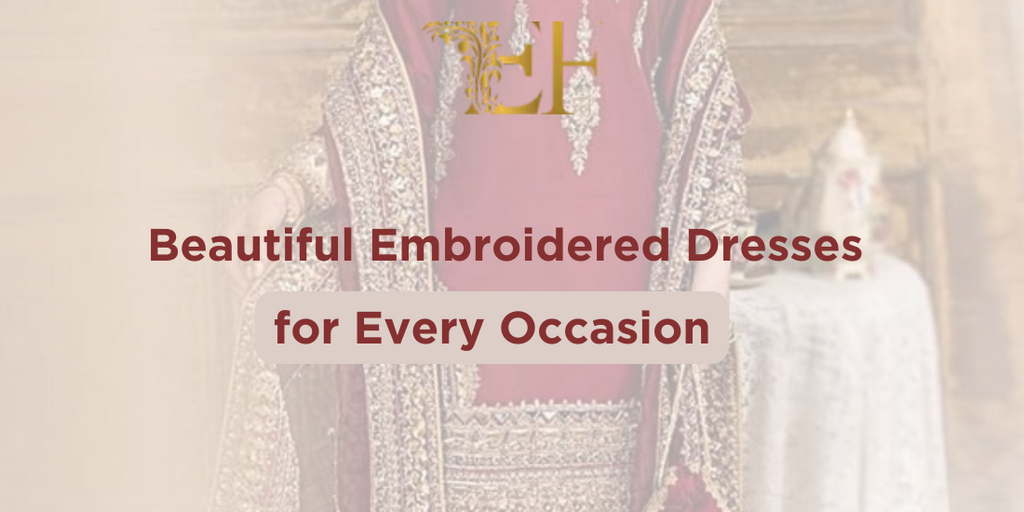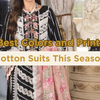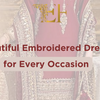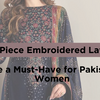Beautiful Embroidered Dresses for Every Occasion

Embroidered dresses have long been a symbol of elegance, craftsmanship, and cultural heritage. From delicate floral embroidery on breezy summer dresses to opulent, heavily embroidered gowns designed for weddings, these outfits have a timeless appeal. Embroidery transforms simple fabrics into intricate works of art, adding depth, texture, and a touch of sophistication.
Whether you're dressing for a casual get-together, an office function, or a lavish celebration, there's an embroidered suit for every occasion. In this guide, we’ll dive into the history of embroidery in fashion, explore different embroidery techniques, and share expert styling tips to help you wear these exquisite pieces with confidence.
The Art of Embroidery in Fashion
Embroidery is more than just decoration it's a way of storytelling, weaving together culture, tradition, and artistry through threads and patterns.
A Brief History of Embroidery in Clothing
-
Ancient Times: Originating in civilizations such as Egypt, China, and India, embroidery adorned royal garments and religious attire.
-
Medieval Europe: Nobles and aristocrats showcased their wealth through embroidered clothing made with gold and silver threads.
-
Modern Fashion: Today, embroidery bridges tradition and innovation, appearing in haute couture collections as well as everyday fashion.
Different Embroidery Techniques Used in Dresses
-
Hand Embroidery: A meticulous, time-consuming craft that results in unique, intricate designs.
-
Machine Embroidery: A modern, efficient technique that allows for consistent, high-quality designs in mass production.
-
Zardozi Embroidery: A luxurious embroidery style featuring metallic threads, beads, and pearls—perfect for bridal wear.
-
Chikankari Embroidery: A delicate, floral embroidery from India, ideal for lightweight and breathable fabrics.
-
Thread Work & Resham Embroidery: Silk thread embroidery that gives garments a rich, elegant touch.
Why Choose Embroidered Dresses?
Embroidered dresses offer a blend of tradition, artistry, and versatility, making them a valuable addition to any wardrobe.
Unique Craftsmanship and Detailing
-
Unlike plain or printed dresses, embroidered outfits display intricate craftsmanship.
-
Each pattern tells a unique story, often inspired by heritage and culture.
Versatility for Every Occasion
-
Light embroidery suits casual wear, adding charm without being overpowering.
-
Heavy embroidery makes a grand statement at weddings and festive events.
-
Contemporary embroidery styles blend tradition with modern trends, making them adaptable for all age groups.
Durability and High-Quality Materials
-
Embroidery strengthens fabric, making it more durable over time.
-
Well-maintained embroidered dresses can last for years, making them a worthwhile investment.
Types of Embroidered Dresses
Casual Embroidered Dresses
Perfect for an effortlessly stylish look, casual embroidered dresses are great for day-to-day wear.
-
Best Fabrics: Cotton, linen, and chiffon with light embroidery.
-
Ideal for: Brunches, vacations, and casual outings.
-
Popular Styles: Bohemian maxi dresses, embroidered tunics, and floral sundresses.
Heavy Embroidery Dresses for Special Occasions
For moments that call for elegance and grandeur, heavy embroidery dresses are a go-to choice.
-
Bridal & Wedding Wear: Lavish lehengas, sarees, and gowns adorned with intricate beadwork and metallic threads.
-
Party & Festive Wear: Ornate anarkalis, shararas, and gowns featuring sequins and mirror work.
-
Best Fabrics: Velvet, silk, georgette, and brocade.
Traditional Embroidered Dresses
Different cultures have their own embroidery techniques, each telling a unique story.
-
Indian & Pakistani Embroidery: Chikankari, phulkari, and zardozi are popular styles for festive and bridal attire.
-
Middle Eastern Embroidery: Embroidered kaftans with gold and silver threadwork.
-
Mexican & Spanish Embroidery: Vibrant floral motifs, often found on off-shoulder dresses.
Styling Embroidered Dresses for Different Occasions
Work and Office Wear
-
Opt for subtle embroidery on neutral-toned dresses for a professional look.
-
Choose straight-cut or A-line dresses with minimal detailing.
-
Pair with nude heels and delicate jewelry for a polished finish.
Party and Evening Wear
-
Select heavily embroidered dresses with sequins or beadwork for a glamorous effect.
-
Deep colors like navy blue, burgundy, and emerald green add sophistication.
-
Complete the look with statement jewelry and heels.
Wedding and Festive Wear
-
Opt for luxurious fabrics like silk or velvet with intricate embroidery for a regal appearance.
-
Pair with traditional jewelry, embroidered clutches, and embellished footwear.
Popular Embroidery Styles Around the World
-
Chikankari (India): Elegant floral embroidery on lightweight fabrics.
-
Zardozi (India & Pakistan): Lavish metallic threadwork, perfect for bridal gowns.
-
Phulkari (Punjab, India): Vibrant embroidery, often seen on scarves and salwar suits.
-
Mexican Embroidery: Bold floral motifs on white cotton dresses.
-
Chinese Silk Embroidery: Exquisite, detailed designs made with silk threads.
Heavy Embroidery Dresses: A Symbol of Luxury
Best Occasions for Heavy Embroidered Dresses
-
Weddings & Engagements: Bridal lehengas, sarees, and gowns.
-
Festivals & Celebrations: Statement anarkalis and embroidered shararas.
-
Red Carpet & Evening Events: Designer embroidered gowns with elaborate beadwork.
Best Fabrics for Heavy Embroidery
-
Velvet: Exudes a royal feel.
-
Silk: Provides a smooth, elegant finish.
-
Georgette: Lightweight yet graceful.
How to Choose the Perfect Embroidered Dress?
Based on Body Type
-
Pear-shaped: Flowing silhouettes highlight curves beautifully.
-
Petite: A-line and structured dresses create the illusion of height.
-
Curvy: Vertical embroidery patterns offer a slimming effect.
Based on Season
-
Summer: Lightweight fabrics with minimal embroidery.
-
Winter: Heavier fabrics like velvet and silk with intricate designs.
Maintaining and Caring for Embroidered Dresses
-
Washing Tips: Hand wash delicate embroidery; dry clean heavier designs.
-
Storage Tips: Keep in a muslin cloth to protect embroidery from dust.
-
Removing Stains: Use mild detergents and avoid scrubbing.
Where to Buy the Best Embroidered Dresses?
-
Online Stores: Amazon, Etsy, and designer boutiques offer a range of styles.
-
Local Boutiques: Perfect for customized, handcrafted designs.





